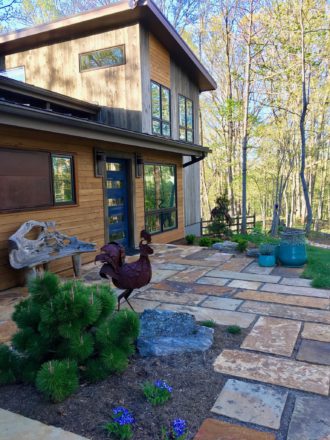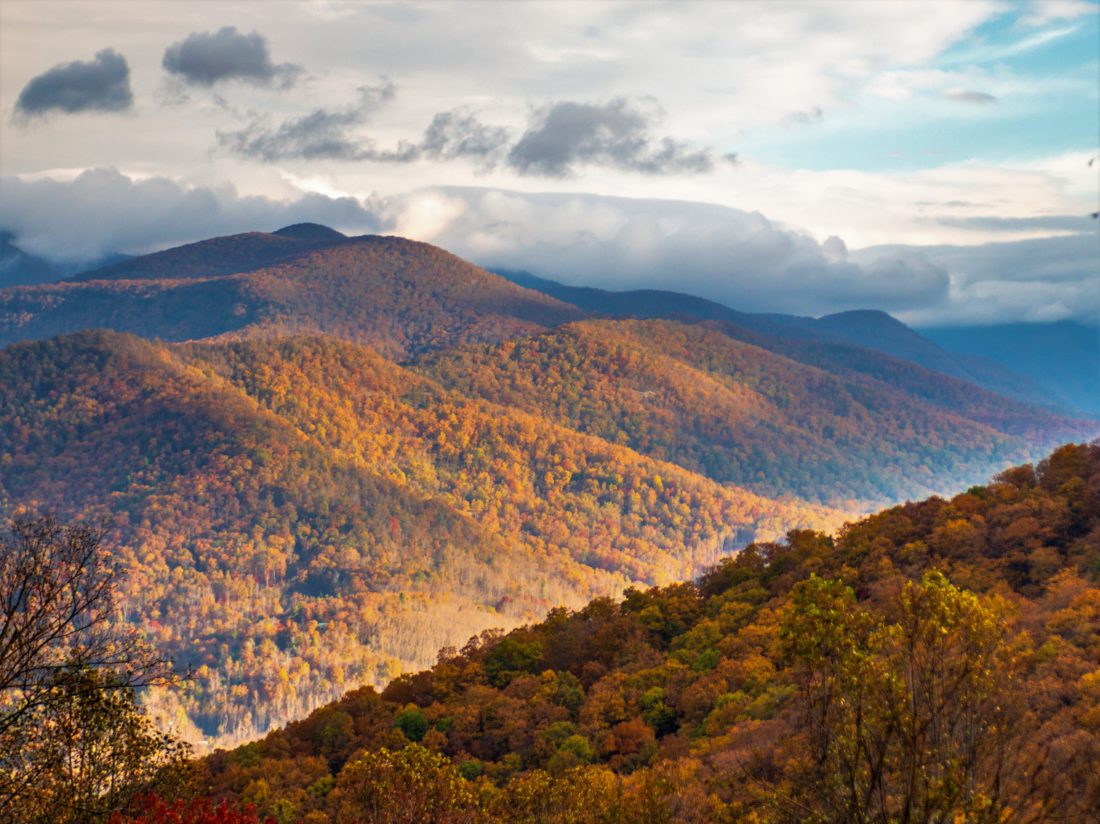The numbers don’t lie. According to census data, Asheville’s population grew by more than 21% between 2000 and 2010, and recent estimates suggest that the city has grown roughly 9% since the last census. In and around town, the signs and sounds of development can be noticed almost everywhere.
More people moving to the area, drawn by the scenic beauty of mountains and rivers, raises uncomfortable questions. Where will all of these newcomers live? And, with flat land at a premium, how can new housing developments accommodate the influx of Ashevilleans without sacrificing water quality or the majesty of unspoiled vistas?
Preserving nature, preserving the view
For conservationists such as Karin Heiman, deputy director of the nonprofit Southeast Regional Land Conservancy, the answers to these questions lie with “sustainably developed” neighborhoods. New construction in what was once wilderness, she says, must take conservation into consideration. Recently, she’s applied that philosophy to developments such as The Preserve at Little Pine in Madison County and the High Hickory neighborhood in Swannanoa, which broke ground in late 2017.
“The Swannanoa Mountains came upon my radar because they are so diverse. The geology is just a little different, so they are rich in plant and animal species,” says Heiman. “I was really excited to protect something in Swannanoa.”
Heiman worked with High Hickory’s developers to come up with a building plan that accommodates new families while keeping construction off the ridges and sacrificing less of the area’s natural beauty. With fewer than 75 homesites planned on over 430 acres, the neighborhood also agreed to set aside 154 acres of contiguous conservation easement land along the ridge, creating a wildlife corridor that connects to a neighboring easement of 167 acres protected by the nonprofit Southern Appalachian Highlands Conservancy.
The site plan clusters the houses closely together, creating a contiguous stretch of natural open space surrounding the neighborhood. This approach reduces the need for roads and cut-ins for power, plumbing and other amenities.
“The land highest on the ridge and most in view of the public has been protected and won’t have any houses. Nothing can be built on the conservation area except trails and observation platforms,” Heiman explains. She continues that the conservation easements at High Hickory will assure that views of the Swannanoa Mountains from the Blue Ridge Parkway, the Mountains-to-Sea Trail and the Interstate 40 corridor, as well as portions of the Asheville area, will remain pristine in perpetuity.
“The world loses 18.7 million acres of forest a year,” Heiman says. “That’s like 27 soccer fields a minute that are disappearing — so whenever we can hold onto some green space, especially around Asheville, which is so scenic, it’s pretty amazing to be able to do that.”
Carl Silverstein, executive director of SAHC, says that High Hickory’s developers contacted his organization about a conservation easement but ultimately decided to go with SRLC due to the nonprofit’s prior experience working with real estate developments.
“[High Hickory] put that ridgeline that adjoins our easement into a permanent protection, which I think we would see as a good thing,” says Silverstein. “We prefer to see a tract wholly in conservation. But once an area is slated to be developed, we definitely prefer to see it clustered and planned properly, and that mitigates all kinds of things, from loss of slope to erosion and flooding issues.”
From ridges to rivers

While some sustainable housing developments focus on protecting the tops of mountains, others are working to keep WNC’s waterways from falling victim to further degradation. The up-and-coming Olivette “agrihood” has begun developing properties on 346 acres along the French Broad River, just over 6 miles to the north of Asheville. The community is situated around a sustainable farm, which is slated to one day feed the entire development.
“We’re planning on having upwards of 250 families at Olivette when it is complete, and the plan is for the farm to feed those families,” says William “Tama” Dickerson, one of the community’s founding members. “We are supporting the farm currently through CSAs, which are available first to the Olivette community and then to outside people as well, and we are also in farmers markets and restaurants in Asheville.”
Sustainable agriculture requires clean water, and the community is stepping up by preserving the buffer zones that protect Asheville’s waterways. In partnership with RiverLink, a local environmental nonprofit, Olivette is planning to establish a permanent easement on its frontage on French Broad river, as well as the adjacent Lee’s Creek tributary.
“We have very stringent deed restrictions,” says Dickerson. “We require a very stringent landscape survey of every large tree on the property and we have to approve all view clearing or any removal of trees.”
RJ Taylor, land protection manager for RiverLink, says he initially reached out to Olivette about creating an easement along the river and found that not only were the community developers receptive to the idea, they were also already researching the process.
The easement will ban all development and tree removal along the edges of the waterways to reduce pollution, erosion and sediment in the river. Like High Hickory, the neighborhood is designed with houses clustered together and surrounded by natural green space to avoid excessive infrastructure cut-ins.
“This is a very smart business decision for these developers as the undeveloped land becomes an amenity to that community,” says Taylor. “Quite often, these homes sell at a premium because they face out on an open space — and not just any open space, space that’s recognized will be permanently protected.”
While Taylor believes that the best thing for the local ecosystem would be to stop new developments from springing up altogether, he says that sustainable development communities such as High Hickory and Olivette are the next best thing and the most realistic solution to a problem that can’t just be wished away. Taylor has put his money where his mouth is — not only is he a consultant for Olivette, but he is also one of the new homeowners at High Hickory.
Sustainable for whom?
With some houses at Olivette selling for over $700,000 and undeveloped tracts of land at High Hickory going for $100,000 to $300,000, living in a sustainably developed community may be far from a financially sustainable choice for most people. “A lot of developments have been a little more high-end because quite often there are larger homes built onto it,” Taylor admits about the houses available at High Hickory and other, similar neighborhoods.
“The buzzword now is affordable living, and I think that Olivette is working in that direction,” Taylor continues. “They are looking at the diversity of different home styles that can be put in; maybe it’s townhomes or more clustered developments — there is potential.”
That said, Taylor admits that for now, communities like Olivette and High Hickory remain out of reach for lower-income households. “That is the next step, I believe, in these conservation developments, to make it work for everybody such that one can buy into this community and have it be within an affordable level,” he says. “That’s one that needs to be continued to be worked on, in terms of how to make it work for the bottom line.”
Edited at 4:24 p.m. May 24 to reflect the current status of Olivette’s conservation easement.



Before you comment
The comments section is here to provide a platform for civil dialogue on the issues we face together as a local community. Xpress is committed to offering this platform for all voices, but when the tone of the discussion gets nasty or strays off topic, we believe many people choose not to participate. Xpress editors are determined to moderate comments to ensure a constructive interchange is maintained. All comments judged not to be in keeping with the spirit of civil discourse will be removed and repeat violators will be banned. See here for our terms of service. Thank you for being part of this effort to promote respectful discussion.